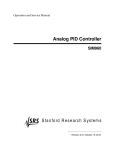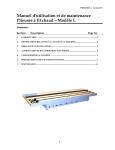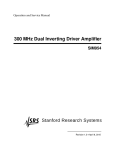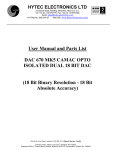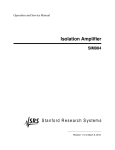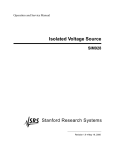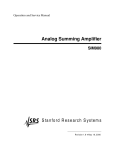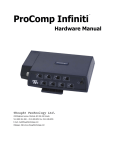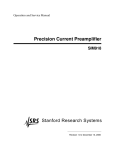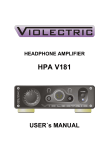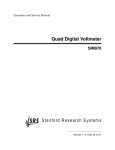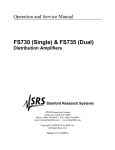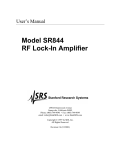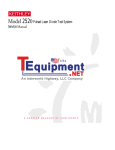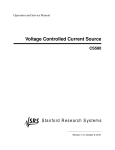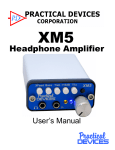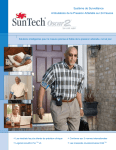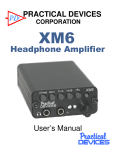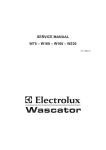Download Manual - Stanford Research Systems
Transcript
Operation and Service Manual Bessel & Butterworth Filter SIM965 Stanford Research Systems Revision 1.7 • August 3, 2011 Certification Stanford Research Systems certifies that this product met its published specifications at the time of shipment. Warranty This Stanford Research Systems product is warranted against defects in materials and workmanship for a period of one (1) year from the date of shipment. Service For warranty service or repair, this product must be returned to a Stanford Research Systems authorized service facility. Contact Stanford Research Systems or an authorized representative before returning this product for repair. Information in this document is subject to change without notice. c Stanford Research Systems, Inc., 2005 – 2011. All rights reserved. Copyright Stanford Research Systems, Inc. 1290–D Reamwood Avenue Sunnyvale, CA 94089 USA Phone: (408) 744-9040 • Fax: (408) 744-9049 www.thinkSRS.com • e-mail: [email protected] Printed in U.S.A. Document number 9-01597-903 SIM965 Bessel & Butterworth Filter Contents General Information Safety and Preparation for Use Symbols . . . . . . . . . . . . . Notation . . . . . . . . . . . . . Specifications . . . . . . . . . . 1 2 3 . . . . Operation 1.1 Overview . . . . . . . . . . . 1.2 Nominal transfer functions 1.3 Front-Panel Operation . . . 1.4 Clock Stopping . . . . . . . 1.5 SIM Interface . . . . . . . . . . . . . . . . . . . . . . . . . . . Remote Operation 2.1 Index of Common Commands . 2.2 Alphabetic List of Commands . 2.3 Introduction . . . . . . . . . . . 2.4 Commands . . . . . . . . . . . . 2.5 Status Model . . . . . . . . . . . . . . . . . . . . . . . . . . . . . . . . . . . . . . . . . . . . . . . . . . . . . . . . . . . . . . . . . . . . . . . . . . . . . . . . . . . . . . . . . . . . . . . . . . . . . . . . . . . . . . . . . . . . . . . . . . . . . . . . . . . . . . . . . . . . . . . . . . . . . . . . . . . . . . . . . . . . . iii iii iv v vi . . . . . . . . . . . . . 1–1 . 1–2 . 1–3 . 1–8 . 1–9 . 1 – 10 . . . . . 2–1 . 2–2 . 2–4 . 2–6 . 2–6 . 2 – 16 Circuitry 3.1 Circuit Descriptions . . . . . . . . . . . . . . . . . . . 3.2 Parts Lists . . . . . . . . . . . . . . . . . . . . . . . . 3.3 Schematic Diagrams . . . . . . . . . . . . . . . . . . 3–1 . 3–2 . 3–4 . 3–6 i ii Contents SIM965 Bessel & Butterworth Filter General Information The SIM965 Analog Filter, part of Stanford Research Systems’ Small Instrumentation Modules family, is a continuous-time, programmable filter capable of high-pass and low-pass operation as a Butterworth or Bessel filter. Safety and Preparation for Use The front-panel input, front-panel output, and the rear-panel output coaxial (BNC) connectors in the SIM965 are referenced to the Earth, and their outer casings are grounded. No dangerous voltages are generated by the module. WARNING Do not exceed ±15 volts to the Earth at the center terminal of any BNC connector. Do not install substitute parts or perform unauthorized modifications to this instrument. The SIM965 is a single-wide module designed to be used inside the SIM900 Mainframe. Do not turn on the power until the module is completely inserted into the mainframe and locked in place. iii iv General Information Symbols you may Find on SRS Products Symbol Description Alternating current Caution - risk of electric shock Frame or chassis terminal Caution - refer to accompanying documents Earth (ground) terminal Battery Fuse On (supply) Off (supply) SIM965 Bessel & Butterworth Filter General Information v Notation The following notation will be used throughout this manual. WARNING A warning means that injury or death is possible if the instructions are not obeyed. CAUTION A caution means that damage to the instrument or other equipment is possible. Typesetting conventions used in this manual are: • Front-panel buttons are set as [Button]; [Adjust ] is shorthand for “[Adjust ] & [Adjust ]”. • Front-panel indicators are set as Overload. • Remote command names are set as *IDN?. • Literal text other than command names is set as OFF. Remote command examples will all be set in monospaced font. In these examples, data sent by the host computer to the SIM965 are set as straight teletype font, while responses received by the host computer from the SIM965 are set as slanted teletype font. SIM965 Bessel & Butterworth Filter vi General Information Specifications Performance Characteristics Min Input Impedance Coupling Gain AC-coupling time const. Range, 48 dB/oct Butterworth 36 dB/oct Butterworth all others Filter Band Cutoff frequency Resolution Accuracy Type Rolloff Output Noise THD Operating Temperature Power Supply current, +5 V ±15 V Typ Max 1 AC or DC 1× 1 −5 +5 −7 +7 −10 +10 low-pass or high-pass 1.00 5 × 105 3 −1 +1 Butterworth, Bessel 12, 24, 36, 48 Units MΩ s V Hz digits % dB/octave < 200µVrms (1 MHz bandwidth) 0.01 % (−80 dB) at 1 kHz 0 40 +5, ±15 100 300 ◦ C, non-condensing V DC mA mA General Characteristics Interface Connectors Weight Dimensions Serial (RS-232) through SIM interface BNC (2 front, 1 rear) DB–15 (male) SIM interface 3 lbs 1.500 W × 3.600 H × 7.000 D SIM965 Bessel & Butterworth Filter 1 Operation This chapter gives you the necessary information to get started quickly with the SIM965 Analog Filter. In This Chapter 1.1 1.2 1.3 1.4 1.5 Overview . . . . . . . . . . . . Nominal transfer functions . . 1.2.1 Butterworth filters . . . 1.2.2 Bessel filters . . . . . . . 1.2.3 High-pass filters . . . . Front-Panel Operation . . . . . 1.3.1 Frequency . . . . . . . . 1.3.2 Type . . . . . . . . . . . 1.3.3 Filter . . . . . . . . . . . 1.3.4 Slope . . . . . . . . . . . 1.3.5 Input . . . . . . . . . . . 1.3.6 Output . . . . . . . . . . Clock Stopping . . . . . . . . . SIM Interface . . . . . . . . . . 1.5.1 SIM interface connector 1.5.2 Direct interfacing . . . . . . . . . . . . . . . . . . . . . . . . . . . . . . . . . . . . . . . . . . . . . . . . . . . . . . . . . . . . . . . . . . . . . . . . . . . . . . . . . . . . . . . . . . . . . . . . . . . . . . . . . . . . . . . . . . . . . . . . . . . . . . . . . . . . . . . . . . . . . . . . . . . . . . . . . . . . . . . . . . . . . . . . . . . . . . . . . . . . . . . . . . . . . . . . . . . . . . . . . . . . . . . . . . . . 1–2 1–3 1–3 1–3 1–6 1–8 1–8 1–8 1–8 1–8 1–8 1–9 1–9 1 – 10 1 – 10 1 – 10 1–1 1–2 1.1 Operation Overview The SIM965 Analog Filter is a continuous-time, digitally-programmable filter with fully analog signal paths. By using a modified statevariable circuit design, the SIM965 provides a variety of programmed filter configurations. From the front panel, the user can select a Butterworth filter, for maximum passband gain flatness, or a Bessel filter, for minimum pulse overshoot and constand time delay in the passband. The user can also select either a low-pass or high-pass filter, and change the order of the filter between 2nd , 4th , 6th , or 8th order, corresponding to 12, 24, 36 or 48 dB/octave roll-off in the stop band. For any filter configuration, a single continuous parameter, the “cutoff frequency,” fc can be set with 3-digit resolution (and ±1 % accuracy) in the range of 1 Hz to 500 kHz. For Butterworth filters, fc corresponds to the frequency at which the filter response is −3 dB. For Bessel filters, fc is determined so that the far-stop-band attenuation slope asymptotically approaches that of the Butterworth filter. Figure 1.1: The SIM965 front and rear panels. SIM965 Bessel & Butterworth Filter 1.2 1.2 Nominal transfer functions 1–3 Nominal transfer functions The SIM965 circuitry is configured to provide a near-ideal Butterworth or Bessel filter transfer function for the user. 1.2.1 Butterworth filters For a Butterworth filter, the nominal transfer function for an nthorder low pass filter is given by: s 1 Gn ( f ) = (1.1) 1 + η2n where, for low-pass filters, η = ( f / f0 ), and f0 = fc , the −3 dB frequency of the response function. Figures 1.2 and 1.3 show the frequency and step response for Butterworth low-pass filters. 1.2.2 Bessel filters For Bessel filters, the nominal transfer function for an nth-order low pass filter is given by: v t 1 Gn ( f ) = (1.2) B 2 P 2 N N + boN boN where, for low-pass filters, η = ( f / f0 ), and BN , PN , and boN are determined iteratively, based on BN = (2N − 1)B(N−1) − η2 B(N−2) with B0 = 1, B1 = 1, PN = (2N − 1)P(N−1) − η2 P(N−2) with P0 = 0, P1 = η, and boN = (2N − 1) ∗ bo(N−1) with bo0 = 1. Figures 1.4 and 1.5 show the frequency and step response for Bessel low-pass filters. The SIM965 uses a frequency normalization for Bessel filters such that the far-stop-band response asymptotically approaches that of the same-order Butterworth filter. Table 1.1 gives the scaling factors to obtain the formal f0 (needed for the Bessel formulae) and the actual −3 dB frequency, in terms of the SIM965 setting fc . For example, for a 6-pole low-pass Bessel filter with fc = 100 Hz can be calculated using f0 = 0.21409 × fc , or 21.409 Hz. SIM965 Bessel & Butterworth Filter 1–4 Operation 0 -10 Response [dB] -20 12 dB/octave -30 -40 24 36 -50 48 dB/octave -60 100 Hz 1 kHz 10 kHz Frequency Figure 1.2: The nominal frequency response for Butterworth lowpass filters of various orders. All filters are tuned to fc = 1 kHz. 1.2 1 12 Response 0.8 24 0.6 36 48 dB/octave 0.4 0.2 0 0 0.5 1 1.5 2 Time (ms) 2.5 3 3.5 4 Figure 1.3: The nominal step response for Butterworth low-pass filters of various orders. All filters are tuned to fc = 1 kHz. SIM965 Bessel & Butterworth Filter 1.2 Nominal transfer functions 1–5 0 -10 Response [dB] -20 12 dB/octave -30 -40 36 -50 24 48 dB/octave -60 100 Hz 1 kHz 10 kHz Frequency Figure 1.4: The nominal frequency response for Bessel low-pass filters of various orders. All filters are tuned to fc = 1 kHz. 1.2 1 Response 0.8 12 24 0.6 36 0.4 48 dB/octave 0.2 0 0 0.5 1 1.5 2 Time (ms) 2.5 3 3.5 4 Figure 1.5: The nominal step response for Bessel low-pass filters of various orders. All filters are tuned to fc = 1 kHz. SIM965 Bessel & Butterworth Filter 1–6 Operation Order 2 4 6 8 f0 0.577 39 × 0.312 43 × 0.214 09 × 0.162 83 × f−3 dB fc fc fc fc 0.786 2 × 0.660 4 × 0.578 7 × 0.517 7 × fc fc fc fc Table 1.1: Bessel filter normalization factors 1.2.3 High-pass filters To obtain the formulae for a high-pass Butterworth filter, simply substitute η = ( f0 / f ) into Equation 1.1. For a high-pass Bessel filter, one similarly substitutes η = ( f / f0 ) into Equation 1.2. However, the scaling factors from Table 1.1 must be inverted. For example, a 6–pole high-pass Bessel filter with fc = 100 Hz can be calculated using f0 = fc ÷ 0.21409, or 467.09 Hz. Figures 1.6 and 1.7 show the frequency response for Butterworth and Bessel high-pass filters. SIM965 Bessel & Butterworth Filter 1.2 Nominal transfer functions 1–7 0 -10 Response [dB] -20 12 dB/octave 24 -30 36 48 dB/octave -40 -50 -60 100 Hz 1 kHz Frequency 10 kHz Figure 1.6: The nominal frequency response for Butterworth highpass filters of various orders. All filters are tuned to fc = 1 kHz. 0 -10 12 dB/octave Response [dB] -20 -30 24 36 -40 48 dB/octave -50 -60 100 Hz 1 kHz Frequency 10 kHz Figure 1.7: The nominal frequency response for Bessel high-pass filters of various orders. All filters are tuned to fc = 1 kHz. SIM965 Bessel & Butterworth Filter 1–8 1.3 Operation Front-Panel Operation All settings of the SIM965 can be set from the front panel (see Figure 1.1). 1.3.1 Frequency The cutoff frequency can be incremented or decremented using the [Freq. ] buttons. Pressing either [Freq. ] or [Freq. ] once will cause the least significant digit in the display to increment (or decrement) by one. If the button is held down, the display will begin to change at a steadily-increasing rate, accelerating to allow large fc changes to be made easily. Note that the circuitry is not reprogrammed until the button is released. 1.3.2 Type The [Type] button allows the user to toggle between Butterworth or Bessel filter type. 1.3.3 Filter The [Filter] button allows the user to toggle between high pass or low pass filter pass band. 1.3.4 Slope The [Slope] button allows the user to cycle through the four available stop band roll-off rates: 12, 24, 36 and 48 dB/octave. 1.3.5 Input Input signals to the SIM965 at the front-panel BNC connector in the “Input” block. If the input signal exceeds the specified ±10 V range, the Ovld indicator will light and remain on as long as the signal exceeds the specified input range. 1.3.5.1 Couple The [Coupling] button allows the user to toggle the input coupling of the SIM965 between AC and DC coupling. When AC-coupled, the input is high-pass filtered by a single-pole RC filter with a 1 second time constant. SIM965 Bessel & Butterworth Filter 1.4 1.3.6 Clock Stopping 1–9 Output The filtered signal is available from the SIM965 at the front-panel BNC connector in the “Output” block. A second output connector is available on the rear panel as well. Each output is (separately) connected the filter circuitry through an internal 50 Ω resistor. 1.4 Clock Stopping The microprocessor clock of the SIM965 stops if the module is idle, “freezing” the digital circuitry. The following actions “wake up” the clock: 1. A power-on. 2. A press of a front-panel button. 3. Activity (send or receive) at the remote interface. 4. An overload. The clock runs for as long as is necessary to complete a filter setting adjustment, or to communicate the output of a query through the remote interface. However, the clock will remain active for as long as the overload condition exists. This default behavior can be modified with the remote command AWAK. Setting AWAK ON will prevent the clock from stopping. The module returns to AWAK OFF upon power-on. SIM965 Bessel & Butterworth Filter 1 – 10 1.5 Operation SIM Interface The primary connection to the SIM965 Analog Filter is the rear-panel DB–15 SIM interface connector. Typically, the SIM965 is mated to a SIM900 Mainframe via this connection, either through one of the internal Mainframe slots, or the remote cable interface. It is also possible to operate the SIM965 directly, without using the SIM900 Mainframe. This section provides details on the interface. CAUTION 1.5.1 The SIM965 has no internal protection against reverse polarity, missing supply, or overvoltage on the power supply pins. Misapplication of power may cause circuit damage. SRS recommends using the SIM965 together with the SIM900 Mainframe for most applications. SIM interface connector The DB–15 SIM interface connector carries all the power and communications lines to the instrument. The connector signals are specified in Table 1.2 Pin 1 2 3 4 5 6 7 8 9 10 11 12 13 14 15 Direction Src ⇒ Dest Signal SIGNAL GND −STATUS RTS CTS −REF 10MHZ −5 V −15 V PS RTN CHASSIS GND TXD RXD +REF 10MHz +5 V +15 V +24 V MF ⇒ SIM SIM ⇒ MF MF ⇒ SIM SIM ⇒ MF MF ⇒ SIM MF ⇒ SIM MF ⇒ SIM MF ⇒ SIM MF ⇒ SIM SIM ⇒ MF MF ⇒ SIM MF ⇒ SIM MF ⇒ SIM MF ⇒ SIM Description Ground reference for signal Status/service request (GND = asserted, +5 V= idle) HW handshake (unused in SIM965) HW handshake (unused in SIM965) 10 MHz reference (no connection in SIM965) Power supply (no connection in SIM965) Power supply Power supply return Chassis ground Async data (start bit = “0”= +5 V; “1” = GND) Async data (start bit = “0”= +5 V; “1” = GND) 10 MHz reference (no connection in SIM965) Power supply Power supply Power supply (no connection in SIM965) Table 1.2: SIM Interface Connector Pin Assignments, DB-15 1.5.2 Direct interfacing The SIM965 is intended for operation in the SIM900 Mainframe, but users may wish to directly interface the module to their own systems without the use of additional hardware. SIM965 Bessel & Butterworth Filter 1.5 SIM Interface 1 – 11 The mating connector needed is a standard DB–15 receptacle, such as Tyco part # 747909–2 (or equivalent). Clean, well-regulated supply voltages of +5, ±15 V DC must be provided, following the pin-out specified in Table 1.2. Ground must be provided on pins 1 and 8, with chassis ground on pin 9. Note that internally the SIM965 ties all three of these terminals, pins 1, 8, and 9, together to form the internal ground. The −STATUS signal may be monitored on pin 2 for a low-going TTL-compatible output indicating a status message. 1.5.2.1 Direct interface cabling If the user intends to directly wire the SIM965 independent of the SIM900 Mainframe, communication is usually possible by directly connecting the appropriate interface lines from the SIM965 DB–15 plug to the RS-232 serial port of a personal computer.1 Connect RXD from the SIM965 directly to RD on the PC, TXD directly to TD. In other words, a null-modem style cable is not needed. To interface directly to the DB–9 male (DTE) RS-232 port typically found on contemporary personal computers, a cable must be made with a female DB–15 socket to mate with the SIM965, and a female DB–9 socket to mate with the PC’s serial port. Separate leads from the DB–15 need to go to the power supply, making what is sometimes know as a “hydra” cable. The pin-connections are given in Table 1.3. DB–15/F to SIM965 DB–9/F 10 ←→ 3 11 ←→ 2 5 Name TxD RxD Computer Ground to P/S 7 ←→ −15 VDC 13 ←→ +5 VDC 14 ←→ +15 VDC 1,8,9 ←→ Ground (chassis, & P/S return) Table 1.3: SIM965 Direct Interface Cable Pin Assignments 1 SIM965 Although the serial interface lines on the DB-15 do not satisfy the minimum voltage levels of the RS-232 standard, they are typically compatible with desktop personal computers Bessel & Butterworth Filter 1 – 12 1.5.2.2 Operation Serial settings The initial serial port settings at power-on are: 9600 Baud, 8–bits, no parity, 1 stop bit, and no flow control. The parity can be changed with the PARI remote command. SIM965 Bessel & Butterworth Filter 2 Remote Operation This chapter describes operating the SIM965 over the serial interface. In This Chapter 2.1 2.2 2.3 2.4 2.5 Index of Common Commands . . . . . . . . . . . . Alphabetic List of Commands . . . . . . . . . . . . Introduction . . . . . . . . . . . . . . . . . . . . . . . 2.3.1 Power-on configuration . . . . . . . . . . . . 2.3.2 Buffers . . . . . . . . . . . . . . . . . . . . . . 2.3.3 Device Clear . . . . . . . . . . . . . . . . . . . Commands . . . . . . . . . . . . . . . . . . . . . . . 2.4.1 Command Syntax . . . . . . . . . . . . . . . . 2.4.2 Notation . . . . . . . . . . . . . . . . . . . . . 2.4.3 Examples . . . . . . . . . . . . . . . . . . . . 2.4.4 Filter Commands . . . . . . . . . . . . . . . . 2.4.5 Serial Communication Commands . . . . . . 2.4.6 Status Commands . . . . . . . . . . . . . . . 2.4.7 Interface Commands . . . . . . . . . . . . . . Status Model . . . . . . . . . . . . . . . . . . . . . . 2.5.1 Status Byte (SB) . . . . . . . . . . . . . . . . . 2.5.2 Service Request Enable (SRE) . . . . . . . . . 2.5.3 Standard Event Status (ESR) . . . . . . . . . 2.5.4 Standard Event Status Enable (ESE) . . . . . 2.5.5 Communication Error Status (CESR) . . . . . 2.5.6 Communication Error Status Enable (CESE) . . . . . . . . . . . . . . . . . . . . . 2–2 2–4 2–6 2–6 2–6 2–6 2–6 2–7 2–8 2–8 2–9 2 – 10 2 – 10 2 – 12 2 – 16 2 – 17 2 – 18 2 – 18 2 – 18 2 – 19 2 – 19 2–1 2–2 2.1 Remote Operation Index of Common Commands symbol i,j f z definition Integers Floating-point values Literal token (?) var {var} [var] Required for queries; illegal for set commands parameter always required required parameter for set commands; illegal for queries optional parameter for both set and query forms Filter FREQ(?) {f } TYPE(?) {z} PASS(?) {z} SLPE(?) {i} COUP(?) {z} 2–9 2–9 2–9 2–9 2–9 Filter Frequency Filter type Filter pass band Filter slope Input coupling Serial Communications PARI(?) {z} 2 – 10 Parity Status *STB? [i] *SRE(?) [i,] {j} *CLS *ESR? [i] *ESE(?) [i,] {j} CESR? [i] CESE(?) [i,]{j} OVLD? PSTA(?) {z} 2 – 10 2 – 10 2 – 10 2 – 10 2 – 11 2 – 11 2 – 11 2 – 11 2 – 11 Status Byte Service Request Enable Clear Status Standard Event Status Standard Event Status Enable Comm Error Status Comm Error Status Enable Overload Pulse −STATUS Mode Interface *RST *IDN? *OPC(?) CONS(?) {z} AWAK(?) {z} LEXE? LCME? LBTN? TOKN(?) {z} TERM(?) {z} 2 – 12 2 – 12 2 – 12 2 – 13 2 – 13 2 – 13 2 – 14 2 – 14 2 – 15 2 – 15 Reset Identify Operation Complete Console Mode Awake mode Execution Error Command Error Button Token Mode Response Termination SIM965 Bessel & Butterworth Filter 2.1 Index of Common Commands SIM965 Bessel & Butterworth Filter 2–3 2–4 2.2 Remote Operation Alphabetic List of Commands ? *CLS *ESE(?) [i,] {j} *ESR? [i] *IDN? *OPC(?) *RST *SRE(?) [i,] {j} *STB? [i] 2 – 10 2 – 11 2 – 10 2 – 12 2 – 12 2 – 12 2 – 10 2 – 10 Clear Status Standard Event Status Enable Standard Event Status Identify Operation Complete Reset Service Request Enable Status Byte A AWAK(?) {z} 2 – 13 Awake mode C CESE(?) [i,]{j} CESR? [i] CONS(?) {z} COUP(?) {z} 2 – 11 2 – 11 2 – 13 2–9 Comm Error Status Enable Comm Error Status Console Mode Input coupling F FREQ(?) {f } 2 – 9 Filter Frequency L LBTN? LCME? LEXE? 2 – 14 Button 2 – 14 Command Error 2 – 13 Execution Error O OVLD? 2 – 11 Overload P PARI(?) {z} PASS(?) {z} PSTA(?) {z} 2 – 10 Parity 2 – 9 Filter pass band 2 – 11 Pulse −STATUS Mode S SLPE(?) {i} 2 – 9 Filter slope T TERM(?) {z} TOKN(?) {z} 2 – 15 Response Termination 2 – 15 Token Mode SIM965 Bessel & Butterworth Filter 2.2 Alphabetic List of Commands TYPE(?) {z} SIM965 Bessel & Butterworth Filter 2–5 2 – 9 Filter type 2–6 2.3 Remote Operation Introduction Remote operation of the SIM965 is through a simple command language documented in this chapter. Both set and query forms of most commands are supported, allowing the user complete control of the filter from a remote computer, either through the SIM900 Mainframe or directly via RS-232 (see Section 1.5.2.1). See Table 1.2 for specification of the DB–15 SIM interface connector. 2.3.1 Power-on configuration The settings for the remote interface are 9600 baud with no parity and no flow control, and local echo disabled (CONS OFF). Most of the SIM965 instrument settings are stored in non-volatile memory, and at power-on the instrument returns to the state it was last in when power was removed. Exceptions are noted in the command descriptions. Reset values of parameters are shown in boldface. 2.3.2 Buffers Incoming data from the host interface is stored in a 32-byte input buffer. Characters accumulate in the input buffer until a command terminator (either hCRi or hLFi) is received, at which point the message is parsed and executed. Query responses from the SIM965 are buffered in a 32-byte output queue. If the input buffer overflows, then all data in both the input buffer and the output queue are discarded, and an error is recorded in the CESR and ESR status registers. 2.3.3 Device Clear The SIM965 host interface can be asynchronously reset to its poweron configuration by sending an RS-232-style hbreaki signal. From the SIM900 Mainframe, this is accomplished with the SIM900 SRST command; if directly interfacing via RS-232, then use a serial break signal. After receiving the Device Clear, the interface is reset and CONS mode is turned OFF. Note that this only resets the communication interface; the basic function of the SIM965 is left unchanged; to reset the instrument, see *RST. 2.4 Commands This section provides syntax and operational descriptions for remote commands. SIM965 Bessel & Butterworth Filter 2.4 2.4.1 Commands 2–7 Command Syntax The four letter mnemonic (shown in CAPS) in each command sequence specifies the command. The rest of the sequence consists of parameters. Commands may take either set or query form, depending on whether the “?” character follows the mnemonic. Set only commands are listed without the “?”, query only commands show the “?” after the mnemonic, and optionally query commands are marked with a “(?)”. Parameters shown in { } and [ ] are not always required. Parameters in { } are required to set a value, and are omitted for queries. Parameters in [ ] are optional in both set and query commands. Parameters listed without any surrounding characters are always required. Do not send ( ) or { } or [ ] as part of the command. Multiple parameters are separated by commas. Multiple commands may be sent on one command line by separating them with semicolons (;) so long as the input buffer does not overflow. Commands are terminated by either hCRi or hLFi characters. Null commands and whitespace are ignored. Execution of command(s) does not begin until the command terminator is received. tokens Token parameters (generically shown as z in the command de- scriptions) can be specified either as a keyword or integer value. Command descriptions list the valid keyword options, with each keyword followed by its corresponding integer value. For example, to set the response termination sequence to hCRi+hLFi, the following two commands are equivalent: TERM CRLF —or— TERM 3 For queries that return token values, the return format (keyword or integer) is specified with the TOKN command. SIM965 Bessel & Butterworth Filter 2–8 2.4.2 Remote Operation Notation The following table summarizes the notation used in the command descriptions: 2.4.3 symbol i,j f z definition Integers Floating-point values Literal token (?) var {var} [var] Required for queries; illegal for set commands parameter always required required parameter for set commands; illegal for queries optional parameter for both set and query forms Examples Each command is provided with a simple example illustrating its usage. In these examples, all data sent by the host computer to the SIM965 are set as straight teletype font, while responses received the host computer from the SIM965 are set as slanted teletype font. The usage examples vary with respect to set/query, optional parameters, and token formats. These examples are not exhaustive, but are intended to provide a convenient starting point for user programming. SIM965 Bessel & Butterworth Filter 2.4 2.4.4 Commands 2–9 Filter Commands FREQ(?) {f } Filter Frequency Set (query) the filter cutoff frequency in Hz. The valid range for f is 1.00 to 5.00e+5. If f is out of range, it will be ignored and the frequency will remain unchanged. f can be given in either decimal form (1270 or 3.14) or exponential notation (1.27E+3 or 3.14E+0), but in all cases the value will be truncated to 3 digits. Digit truncation occurs after range checking, so the value 5.001e+5 is out-of-range and would be rejected. Example: FREQ 12345 FREQ? 1.23E+04 TYPE(?) {z} Filter type Set (query) the filter type {to z = ((BUTTER 0, BESSEL 1)}. Example: TYPE BESSEL TYPE? 1 PASS(?) {z} Filter pass band Set (query) the filter pass band {to z = ((LOWPASS 0, HIGHPASS 1)}. Example: PASS? LOWPASS SLPE(?) {i} Filter slope Set (query) the filter stop band rolloff rate {to i = (12, 24, 36, 48 dB/octave)}. Example: SLPE 24 SLPE? 24 COUP(?) {z} Input coupling Set (query) the SIM965 input coupling {to z = (DC 0, AC 1)}. Example: COUP 1 COUP? AC SIM965 Bessel & Butterworth Filter 2 – 10 2.4.5 Remote Operation Serial Communication Commands PARI(?) {z} Parity Set (query) parity {to z = (NONE 0, ODD 1, EVEN 2, MARK 3, SPACE 4)}. After power-on, modules default to PARI NONE. Example: PARI EVEN 2.4.6 Status Commands The Status commands query and configure registers associated with status reporting of the SIM965. *STB? [i] Status Byte Reads the Status Byte register [bit i]. Execution of the *STB? query (without the optinal bit i) always causes the −STATUS signal to be deasserted. Note that *STB? i will not clear −STATUS, even if bit i is the only bit presently causing the −STATUS signal. See also the PSTA command. Example: *STB? 16 *SRE(?) [i,] {j} Service Request Enable Set (query) the Service Request Enable register [bit i] {to j}. Example: *SRE 0,1 *CLS Clear Status *CLS immediately clears the ESR and CESR registers, and the OVLD bit in the Status Byte. Example: *CLS *ESR? [i] Standard Event Status Reads the Standard Event Status Register [bit i]. Upon executing *ESR?, the returned bit(s) of the ESR register are cleared. Example: *ESR? 64 SIM965 Bessel & Butterworth Filter 2.4 Commands *ESE(?) [i,] {j} 2 – 11 Standard Event Status Enable Set (query) the Standard Event Status Enable Register [bit i] {to j}. Example: *ESE 6,1 ESE? 64 CESR? [i] Comm Error Status Query Comm Error Status Register [for bit i]. Upon executing a CESR? query, the returned bit(s) of the CESR register are cleared. Example: CESR? 0 CESE(?) [i,]{j} Comm Error Status Enable Set (query) Comm Error Status Enable Register [for bit i] {to j} Example: CESE? 0 Overload OVLD? Query the current overload condition. The SIM965 responds with 1 during a signal overload, and 0 at all other times. OVLD? always returns the realtime value of overload, independent of the value of the OVLD bit in the Status Byte. Example: OVLD? 0 PSTA(?) {z} Pulse −STATUS Mode Set (query) the Pulse −STATUS Mode {to z=(OFF 0, ON 1)}. When PSTA ON is set, any new service request will only pulse the −STATUS signal low (for a minimum of 1 µs). The default behavior is to latch −STATUS low until a *STB? query is received. At power-on, PSTA is set to OFF. Example: PSTA? OFF SIM965 Bessel & Butterworth Filter 2 – 12 2.4.7 Remote Operation Interface Commands Interface commands provide generic control over the interface between the SIM965 and the host computer. *RST Reset Reset the SIM965 to default configuration. The following commands are internally executed upon *RST: • FREQ 1.00E+3 • TYPE BUTTER • PASS LOWPASS • SLPE 12 • COUP DC • AWAK OFF • TOKN OFF Example: *RST *IDN? Identify Read the device identification string. The identification string is formatted as: Stanford Research Systems,SIM965,s/n******,ver#.# where ****** is the 6-digit serial number, and #.# is the firmware revision level. Example: *IDN? Stanford Research Systems,SIM965,s/n003075,ver3.0 *OPC(?) Operation Complete Operation Complete. Sets the OPC flag in the ESR register. The query form *OPC? writes a 1 in the output queue when complete, but does not affect the ESR register. Example: *OPC SIM965 Bessel & Butterworth Filter 2.4 Commands CONS(?) {z} 2 – 13 Console Mode Set (query) the Console mode {to z=(OFF 0, ON 1)}. CONS causes each character received at the Input Buffer to be copied to the Output Queue. At power-on and Device-Clear, CONS is set to OFF. Example: CONS? 0 AWAK(?) {z} Awake mode Set (query) the SIM965 keep-awake mode {to z = (OFF 0, ON 1)}. Ordinarily, the clock oscillator for the SIM965 microcontroller is held in a stopped state, and only enabled during processing of events (Section 1.4). Setting AWAK ON forces the clock to stay running, and is useful only for diagnostic purposes. Example: AWAK ON LEXE? Execution Error Query the last execution error code. A query of LEXE? always clears the error code, so a subsequent LEXE? will return 0. Valid codes are: Value 0 1 2 3 16 17 18 Definition No execution error since last LEXE? Illegal value Wrong token Invalid bit Invalid parameter Missing parameter No change Example: *STB? 12; LEXE?; LEXE? 3 0 The error (3, “Invalid bit,”) is because *STB? only allows bit-specific queries of 0–7. The second read of LEXE? returns 0. SIM965 Bessel & Butterworth Filter 2 – 14 LCME? Remote Operation Command Error Query the last command error code. A query of LCME? always clears the error code, so a subsequent LCME? will return 0. Valid codes are: Value 0 1 2 3 4 5 6 7 8 9 10 11 12 13 14 Definition No execution error since last LCME? Illegal command Undefined command Illegal query Illegal set Missing parameter(s) Extra parameter(s) Null parameter(s) Parameter buffer overflow Bad floating-point Bad integer Bad integer token Bad token value Bad hex block Unknown token Example: *IDN LCME? 4 The error (4, “Illegal set”) is due to the missing “?”. LBTN? Button Query the last button-press code. A query of LBTN? always clears the button code, so a subsequent LBTN? will return 0. Valid codes are: Value 0 1 2 3 4 5 6 Definition no button pressed since last LBTN? [Freq. ] [Type] [Freq. ] [Slope] [Filter] [Coupling] Example: LBTN? 1 SIM965 Bessel & Butterworth Filter 2.4 Commands TOKN(?) {z} 2 – 15 Token Mode Set (query) the Token Query mode {to z=(OFF 0, ON 1)}. If TOKN ON is set, then queries to the SIM module that return tokens will return the text keyword; otherwise they return the decimal integer value. Thus, the only possible responses to the TOKN? query are ON and 0. On reset, TOKN is set to OFF. Example: TOKN OFF TERM(?) {z} Response Termination Set (query) the htermi sequence {to z=(NONE 0, CR 1, LF 2, CRLF 3, LFCR 4)}. The htermi sequence is appended to all query responses sent by the module, and is constructed of ASCII character(s) 13 (carriage return) and 10 (line feed). The token mnemonic gives the sequence of characters. At power-on, TERM is set to CRLF. Example: TERM? 3 SIM965 Bessel & Butterworth Filter 2 – 16 2.5 Remote Operation Status Model The SIM965 status registers follow the hierarchical IEEE–488.2 format. A block diagram of the status register array is given in Figure 2.1. Communication Error Status DCAS: Device Clear 7 CTSH: CTS Halted 6 7 RTSH: RTS Halted 5 OVR: Input Buffer Overrun 4 5 HWOVRN: Hardware Input Overrun 3 NOISE: Noise Error 2 3 FRAME: Framing Error 1 PARITY: Parity Error 0 1 CESR 6 4 2 0 CESE Standard Event Status PON: Power On 7 URQ: User Request 6 CME: Command Error 5 7 EXE: Execution Error 4 DDE: Device Error 3 4 6 5 3 2 QYE: Query Error 2 INP: Input Buffer Error 1 1 OPC: Operation Complete 0 0 ESR ESE Status Byte 7 7 CESB 6 X MSS 5 5 ESB 4 4 IDLE 3 3 undef 2 2 undef 1 1 undef 0 SB 0 OVLD SRE -STATUS Figure 2.1: Status Register Model for the SIM965. There are two categories of registers in the SIM965 status model: Event Registers : These read-only registers record the occurrence of defined events. When the event occurs, the corresponding bit is set to 1. Upon querying an event register, any set bits within it are cleared. These are sometimes known as “sticky bits,” since once set, a bit can only be cleared by reading its value. Event register names end with SR. Enable Registers : These read/write registers define a bitwise mask for their corresponding event register. If any bit position is set in an event register while the same bit position is also set in the enable register, then the corresponding summary bit message is set. Enable register names end with SE. SIM965 Bessel & Butterworth Filter 2.5 2.5.1 Status Model 2 – 17 Status Byte (SB) The Status Byte is the top-level summary of the SIM965 status model. When masked by the Service Request Enable register, a bit set in the Status Byte causes the −STATUS signal to be asserted on the rearpanel SIM interface connector. Typically, −STATUS remains asserted (low) until a *STB? query is received, at which time −STATUS is deasserted (raised)1 . After clearing the −STATUS signal, it will only be re-asserted in response to a new status-generating condition. Weight Bit 1 2 4 8 16 32 64 128 0 1 2 3 4 5 6 7 Flag OVLD undef (0) undef (0) undef (0) IDLE ESB MSS CESB OVLD : Overload Status. Indicates that an overload has occured. IDLE : Indicates that the Input Buffer is empty and the command parser is idle. Can be used to help synchronize SIM965 query responses. ESB : Event Status Bit. Indicates whether one or more of the enabled events in the Standard Event Status Register is true. MSS : Master Summary Status. Indicates whether one or more of the enabled status messages in the Status Byte register is true. Note that while −STATUS is released by the *STB? query, MSS is only cleared when the underlying enabled bit message(s) are cleared. CESB : Communication Error Summary Bit. Indicates whether one or more of the enabled flags in the Communication Error Status Register has become true. The OVLD bit is a “true” event status bit, and after being set by an overload, the “1” value persists until read by the *STB? query. After a *STB? query, the OVLD bit is cleared to “0”, and can only be set back to 1 by a new overload event. The remaining bits in the Status Byte are not cleared by the *STB? query. These bits are only cleared by reading the underlying event registers, or by clearing the corresponding enable registers. 1 SIM965 but see the PSTA command Bessel & Butterworth Filter 2 – 18 2.5.2 Remote Operation Service Request Enable (SRE) Each bit in the SRE corresponds one-to-one with a bit in the SB register, and acts as a bitwise AND of the SB flags to generate the MSS bit in the SB and the −STATUS signal. Bit 6 of the SRE is undefined—setting it has no effect, and reading it always returns 0. This register is set and queried with the *SRE(?) command. This register is cleared at power-on. 2.5.3 Standard Event Status (ESR) The Standard Event Status register consists of 8 event flags. These event flags are all “sticky bits” that are set by the corresponding event, and cleared only by reading or with the *CLS command. Reading a single bit (with the *ESR? i query) clears only bit i. Weight Bit 1 2 4 8 16 32 64 128 0 1 2 3 4 5 6 7 Flag OPC INP QYE DDE EXE CME URQ PON OPC : Operation Complete. Set by the *OPC command. INP : Input Buffer Error. Indicates data has been discarded from the Input Buffer. QYE : Query Error. Indicates data in the Output Queue has been lost. DDE : Device Dependent Error. Not implemented in the SIM965. EXE : Execution Error. Indicates an error in a command that was successfully parsed. Out-of-range parameters are an example. The error code can be queried with LEXE?. CME : Command Error. Indicates a parser-detected error. The error code can be queried with LCME?. URQ : User Request. Indicates a front-panel button was pressed. PON : Power On. Indicates that an off-to-on transition has occurred 2.5.4 Standard Event Status Enable (ESE) The ESE acts as a bitwise AND with the ESR register to produce the single bit ESB message in the Status Byte Register (SB). It can be set and queried with the *ESE(?) command. SIM965 Bessel & Butterworth Filter 2.5 Status Model 2 – 19 This register is cleared at power-on. 2.5.5 Communication Error Status (CESR) The Communication Error Status register consists of 8 event flags; each of which is set by the corresponding event, and cleared only by reading or with the *CLS command. Reading a single bit (with the CESR? i query) clears only bit i. Weight Bit 1 2 4 8 16 32 64 128 0 1 2 3 4 5 6 7 Flag PARITY FRAME NOISE HWOVRN OVR RTSH CTSH DCAS PARITY : Parity Error. Set by serial parity mismatch on incoming data byte. FRAME : Framing Error. Set when an incoming serial data byte is missing the STOP bit. NOISE : Noise Error. Set when an incoming serial data byte does not present a steady logic level during each asynchronous bitperiod window. HWOVRN : Hardware Overrun. Set when an incoming serial data byte is lost due to internal processor latency. Causes the Input Buffer to be flushed, and resets the command parser. OVR : Input Buffer Overrun. Set when the Input Buffer is overrun by incoming data. Causes the Input Buffer to be flushed, and resets the command parser. RTSH : RTS Holdoff Event. Not implemented in the SIM965. CTSH : CTS Holdoff Event. Not implemented in the SIM965. DCAS : Device Clear. Indicates the SIM965 received the Device Clear signal (an RS-232 hbreaki). Clears the Input Buffer and Output Queue, and resets the command parser. 2.5.6 Communication Error Status Enable (CESE) The CESE acts as a bitwise AND with the CESR register to produce the single bit CESB message in the Status Byte Register (SB). It can be set and queried with the CESE(?) command. This register is cleared at power-on. SIM965 Bessel & Butterworth Filter 2 – 20 Remote Operation SIM965 Bessel & Butterworth Filter 3 Parts Lists and Schematics This chapter presents a brief description of the SIM965 circuit design. A complete parts list and circuit schematics are included. In This Chapter 3.1 3.2 3.3 Circuit Descriptions . . . . . . . . . . 3.1.1 Grounding . . . . . . . . . . . . 3.1.2 Microcontroller . . . . . . . . . 3.1.3 Front Panel Display . . . . . . 3.1.4 Input Coupling and Protection 3.1.5 Input Overload Detection . . . 3.1.6 Filter Design . . . . . . . . . . . 3.1.7 Output Circuitry . . . . . . . . Parts Lists . . . . . . . . . . . . . . . . 3.2.1 Digital Board & Front Panel . . 3.2.2 Analog Board . . . . . . . . . . Schematic Diagrams . . . . . . . . . . . . . . . . . . . . . . . . . . . . . . . . . . . . . . . . . . . . . . . . . . . . . . . . . . . . . . . . . . . . . . . . . . . . . . . . . . . . . . . . . . . . . . . . . . . . . . . . . . . . . . . . . . . . . . 3–2 3–2 3–2 3–3 3–3 3–3 3–3 3–4 3–4 3–5 3–6 3–6 3–1 3–2 3.1 Circuitry Circuit Descriptions The SIM965 consists of three separate printed circuit boards: the digital board, the front-panel board, and the analog board. The digital board is directly beneath the left-hand cover (as viewed from the front of the module). Pages 1–3 of the schematics correspond to the digital and front-panel boards. Pages 4–9 are the analog board. 3.1.1 Grounding Internally in the SIM965, JP102-pin 1 (SIGNAL GND) and JP102pin 8 (PS RTN), are tied together on the PCB ground plane. JP102pin 9 (CHASSIS GND) is tied to the module chassis through the mounting screws of JP102. CHASSIS GND is connected to the PCB ground plane through a short wire permanently installed in J101 at the factory. 3.1.2 Microcontroller The SIM965 is controlled by microcontroller U104. The controller is cloced at 5 MHz. A critical aspect of the design is the clock-stop circuitry implemented by U101 and U102. A simple RC-oscillator is enabled or disabled at pin 1 of U102, which is driven by synchronizing flip-flop U101B to ensure that no “runt” clock pulses are produced that would violate U104’s minimum clock periods. Four separate clock-starting signals are combined by U106: • Power-on reset • Overload (any) • Incoming serial data • Front-panel button press The fast start-time of the RC-oscillator ensures that incoming serial data will be correctly decoded by the microcontroller’s UART, even when the clock is started by the serial start bit of the incoming data. When the microcontroller has completed all pending activity, it drives the STOP signal high (pin 8 of U104), effectively halting its own processor clock. In this way, the SIM965 guarantees no digital clock artifacts can be generated during quiescent operation. SIM965 Bessel & Butterworth Filter 3.1 3.1.3 Circuit Descriptions 3–3 Front Panel Display The seven segment displays and LED lamps on the front panel are powered by U204–U208, a daisy-chain of 5 74HC595 serial input shift registers. The currents to the lamps are limited by resistor networks in series with the displays and LEDs. The displays and LEDs are all statically driven (i.e., not multiplexed). 3.1.4 Input Coupling and Protection A relay switch, K301, in parallel with a capacitor C301, allows for DC or AC input coupling. The input signal is buffered by U306. Following that, the signal passes through a soft-limiting clamp circuit to ensure that the input to the filter circuitry does not exceed the ±10 V input range. The limiter consists of resistor R306 and a diode/transistor arrangement to actively sink the resistors output current when the input signal goes out of the desired input range. This clamps the resistors output voltage. This is followed by an additional follower U307 to buffer the signal input to the filter circuitry. 3.1.5 Input Overload Detection Input overload is detected via dual comparator U302 with a wireor’d output arrangement that is level shifted using Q304 and Q305. This signal is input to the controller. 3.1.6 Filter Design The filter design consists of four cascaded biquad state-variable filters, using a combination of analog switches to control the analog signal path. The state-variable design allows for independent control of filter gain, cutoff frequency, and Q-factor. These are shown on pages 5–8 of the schematics (one biquad per page). Component references below are for the first biquad, on page 5 (reference numbers in the 200’s). Equivalent corresponding components for the subsequent stages are numbered in the 300’s, 400’s, and 500’s, respectively. Each biquad filter section consists of four multiplying DACs in series, with multiple feedback paths. The first DAC in the series, U207A controls the filter section gain. The second DAC, U207B controls filter Q-factor. The remaining two DACs, U209A & U209B, are configured as integrators using feedback capacitor banks. Analog multiplexers U203, U204, U205, and U208 select the appropriate capacitor combinations to achieve a desired cutoff frequency range. The integrator DACs allow for trimming of the cutoff frequency. An attractive feature of the state-variable filter architecture is that it provides output “taps” for low pass, high pass, and band pass filters. SIM965 Bessel & Butterworth Filter 3–4 Circuitry These taps are fed to three of the inputs to a 4-pole analog switch. The remaining pole of the switch is connected to the filter input. In this way, the output of the overall filter section circuit can be selected to be either of the three filter types, or the fourth option, to bypass the filter. When the filter is bypassed, a second switch is used to ground the filter section input. This switching arrangement allows each filter section to be switched in or out of the complete cascaded filter to achieve the desired stop band rolloff slope and passband type. 3.1.7 Output Circuitry The output of the final filter stage is routed back to the digital board, which contains the output circuitry (see page 3). U303 and U304 form a composite amplifier for the output driver. This arrangement provides the driving capability of the BUF634 without suffering its large input offset voltage, since the output of U303 is servoed to the noninverting input of U304 via the feedback resistor R315. U305 is a photo-MOS switch that remains off during power-up until the ±15 V rails reach about ±13 V. By then, analog circuitry have settled, permitting the output signal to be connected to the output BNCs without large transients. Until switch U305 closes, the SIM965 output is referenced to ground via R320 (100 k). 3.2 Parts Lists The parts list for the analog board is separate from the digital & front-panel boards. SIM965 Bessel & Butterworth Filter 3.2 Parts Lists 3.2.1 3–5 Digital Board & Front Panel Reference SRS P/N Value Reference SRS P/N Value C101 5-00381 330P R107 4-01511 22K C102 5-00345 4.0-34P R115,R119 4-01503 10K C105,C106,C107,C302,C305 5-00102 4.7U R116,R118,R120 4-01465 270 C108,C109,C110 5-00387 1000P R117,R121,R122 4-01455 100 C201,C202,C203,C204,C205 5-00299 .1U R301,R302,R311,R313,R316 4-01117 1.00K C301 5-00542 1.0U R303,R312 4-01059 249 C306 5-00367 22P R304,R310 4-01242 20.0K C307,C308 5-00318 2.2U/T35 R305 4-01067 301 D101,D102 3-00901 BAS40-06 R306 4-01184 4.99K D103 3-00945 BAT54S R307,R309 4-01280 49.9K D201 3-00425 RED R308 4-01405 1.00M D202,D203,D204,D205,D206, 3-00424 GREEN R314 4-01021 100 D207,D208,D209,D210,D211, R315 4-01104 732 D212,D213 R317 4-01406 0 R320 4-01309 100K D301,D308 3-01357 MMBZ5230 D302 3-00783 MMBZ5226 R325,R326 4-00913 49.9 FP D303 3-01430 BAS40-05 RN201,RN202,RN203, 4-00407 2.7K 1206 MINI D304 3-00901 BAS40-06 RN204,RN205,RN206 D305,D306 3-00230 1N5240A RN207,RN208,RN209,RN210 4-00442 1.2K 1206 MINI D307 3-00783 MMBZ5226 S201,S202,S203,S204,S205, 2-00053 B3F-1052 D309,D310 3-01487 MMBZ5242 S206 J211 1-00636 FLE-123-01-GDVA U101 3-00742 74HC74 J212 1-00637 FTSH-123-04-LMT U102 3-01405 MC74AC00D J302 1-00618 SSW-113-01-G-D U103 3-00903 MAX6348UR44 JP101 1-00302 6 PIN DIF CES U104 3-01379 MC68HC912B32CFU JP102 1-00367 15 PIN D U105 3-01390 25LC640/SN K301 3-00617 DS1E-ML2-DC5V U106 3-00662 74HC14 L101,L102,L103 6-00174 6611 TYPE 43 U108 3-00663 74HC08 PCB 7-01635 SIM965, DIGITAL U201,U202,U203 3-00290 HDSP-A101 Q301,Q302 3-00927 MMBT2907ALT1 U204,U205,U206,U207,U208 3-00787 74HC595 Q303 3-00601 MMBT3904LT1 U302 3-00728 LM393 Q304 3-00580 MMBT3906LT1 U303 3-01221 BUF634P Q305 3-00601 MMBT3904LT1 U304 3-01289 LT1363CS8 Q306 3-00580 MMBT3906LT1 U305 3-01488 AQY221R2S R101,R105,R110,R111,R124, 4-01519 47K U306,U307 3-01218 AD825AR X101,X102,X103,X104,X105, 5-00299 .1U 4-01479 1.0K X106,X107,X108,X109,X301, R125 R102,R112 R103 4-01052 210 X302,X303,X304,X305,X306, R104,R113,R114,R123 4-01527 100K X307,X308,X309,X310 R106 4-01431 10 SIM965 Bessel & Butterworth Filter 3–6 3.2.2 Circuitry Analog Board Reference C203,C204,C303,C304,C403, C404,C503,C504 C205,C208,C305,C308,C405, C408,C505,C508 C209,C210,C309,C310,C409, C410,C509,C510 C211,C212,C311,C312,C411, C412,C511,C512 C213,C214,C313,C314,C413, C414,C513,C514 C215,C216,C315,C316,C415, C416,C515,C516 C217,C218,C317,C318,C417, C418,C517,C518 C219,C220,C319,C320,C419, C420,C519,C520 C221,C222,C321,C322,C421, C422,C521,C522 C223,C224,C323,C324,C423, C424,C523,C524 C225,C226,C325,C326,C425, C426,C525,C526 C227,C228,C327,C328,C427, C428,C527,C528 C229,C230,C329,C330,C429, C430,C529,C530 C231,C232,C331,C332,C431, C432,C531,C532 C235,C236,C335,C336,C435, C436,C535,C536 3.3 SRS P/N Value 5-00371 47P 5-00616 220P 5-00442 .001U 5-00450 .0047U 5-00458 .022U 5-00570 .1U - PPS 5-00617 .47U / 250V 5-00618 2.2U / 250V 5-00574 100P - PPS 5-00573 470P 5-00446 .0022U 5-00454 .01U 5-00462 .047U 5-00619 .22U / 100V 5-00615 4.7U / 63V 5% Reference C238,C239,C338,C339,C438, C439,C538,C539 C240,C340,C440,C540 C241,C341,C441,C541 C242,C243,C244,C245,C342, C343,C344,C345,C442,C443, C444,C445,C542,C543,C544, C545 J113 PC1 R202R302 R401R405 R402 R407 R502 R507 RU507 U201,U202,U301,U302,U401, U402,U501,U502 U203,U204,U206,U208,U303, U304,U306,U308,U403,U404, U406,U408,U503,U504,U506, U508 U205,U305,U405,U505 U207,U209,U307,U309,U407, U409,U507,U509 U210,U310,U410,U510 U211,U311,U411,U511 X201-X220,X301-X320, X401-X420,X501-X520 SRS P/N Value 5-00368 27P 5-00313 1P 5-00625 1.8-6.0P RED 5-00318 2.2U/T35 1-00638 7-01636 4-01208 4-01242 4-01204 4-01280 4-01230 4-01251 4-01364 3-01328 TSW-113-15-G-D SIM965, ANALOG 8.87K 20.0K 8.06K 49.9K 15.0K 24.9K 374K LT1361CS8 3-01386 DG408DY 3-00787 74HC595 3-01171 AD5415YRU 3-01367 DG419DY 3-01369 DG409DY 5-00299 .1U Schematic Diagrams Schematic diagrams follow this page. SIM965 Bessel & Butterworth Filter














































